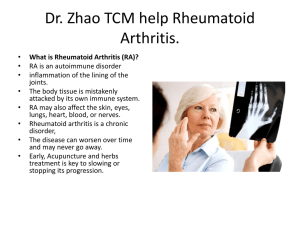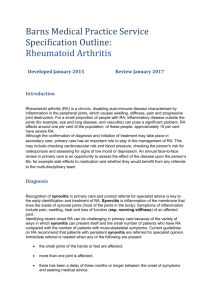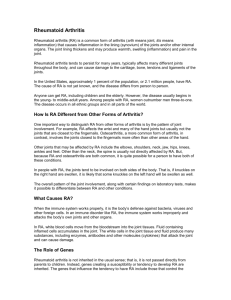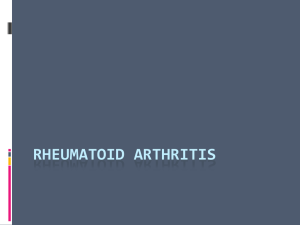Rheumatoid Arthritis: Causes and Symptoms
advertisement
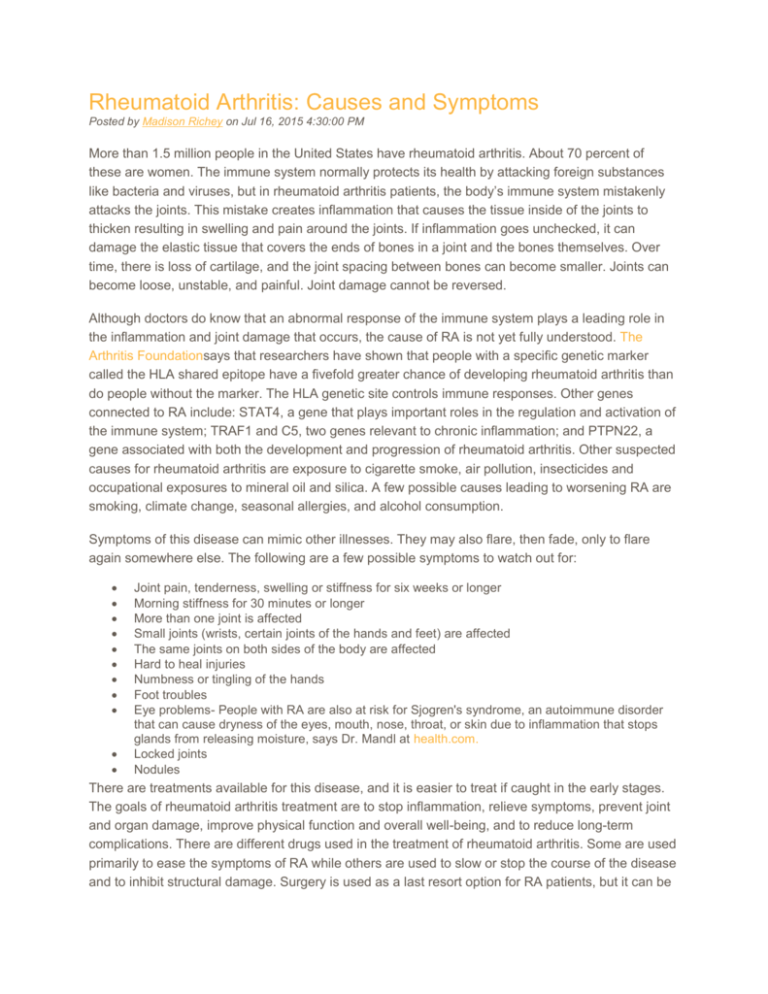
Rheumatoid Arthritis: Causes and Symptoms Posted by Madison Richey on Jul 16, 2015 4:30:00 PM More than 1.5 million people in the United States have rheumatoid arthritis. About 70 percent of these are women. The immune system normally protects its health by attacking foreign substances like bacteria and viruses, but in rheumatoid arthritis patients, the body’s immune system mistakenly attacks the joints. This mistake creates inflammation that causes the tissue inside of the joints to thicken resulting in swelling and pain around the joints. If inflammation goes unchecked, it can damage the elastic tissue that covers the ends of bones in a joint and the bones themselves. Over time, there is loss of cartilage, and the joint spacing between bones can become smaller. Joints can become loose, unstable, and painful. Joint damage cannot be reversed. Although doctors do know that an abnormal response of the immune system plays a leading role in the inflammation and joint damage that occurs, the cause of RA is not yet fully understood. The Arthritis Foundationsays that researchers have shown that people with a specific genetic marker called the HLA shared epitope have a fivefold greater chance of developing rheumatoid arthritis than do people without the marker. The HLA genetic site controls immune responses. Other genes connected to RA include: STAT4, a gene that plays important roles in the regulation and activation of the immune system; TRAF1 and C5, two genes relevant to chronic inflammation; and PTPN22, a gene associated with both the development and progression of rheumatoid arthritis. Other suspected causes for rheumatoid arthritis are exposure to cigarette smoke, air pollution, insecticides and occupational exposures to mineral oil and silica. A few possible causes leading to worsening RA are smoking, climate change, seasonal allergies, and alcohol consumption. Symptoms of this disease can mimic other illnesses. They may also flare, then fade, only to flare again somewhere else. The following are a few possible symptoms to watch out for: Joint pain, tenderness, swelling or stiffness for six weeks or longer Morning stiffness for 30 minutes or longer More than one joint is affected Small joints (wrists, certain joints of the hands and feet) are affected The same joints on both sides of the body are affected Hard to heal injuries Numbness or tingling of the hands Foot troubles Eye problems- People with RA are also at risk for Sjogren's syndrome, an autoimmune disorder that can cause dryness of the eyes, mouth, nose, throat, or skin due to inflammation that stops glands from releasing moisture, says Dr. Mandl at health.com. Locked joints Nodules There are treatments available for this disease, and it is easier to treat if caught in the early stages. The goals of rheumatoid arthritis treatment are to stop inflammation, relieve symptoms, prevent joint and organ damage, improve physical function and overall well-being, and to reduce long-term complications. There are different drugs used in the treatment of rheumatoid arthritis. Some are used primarily to ease the symptoms of RA while others are used to slow or stop the course of the disease and to inhibit structural damage. Surgery is used as a last resort option for RA patients, but it can be an important option for people with permanent damage that limits daily function, mobility, and independence. The procedure involves replacing damaged parts of a joint with metal and plastic parts. If you have unanswered questions about rheumatoid arthritis, feel free to contact the Arthritis Foundation for more information.




